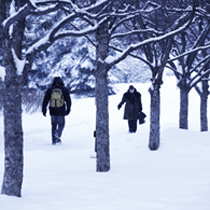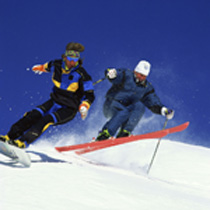VOA慢速英语 2008 1230b
时间:2009-01-05 08:42:06
搜索关注在线英语听力室公众号:tingroom,领取免费英语资料大礼包。
(单词翻译)
VOICE ONE:This is SCIENCE IN THE NEWS, in VOA Special English. I'm Steve Ember.
VOICE TWO:
And I'm Barbara Klein. Today, we tell you everything you ever wanted to know about snow.
(MUSIC)
VOICE ONE:
 Winter weather has returned to northern areas of the world. In much of the United States, winter means the return of snow. Snow is a subject of great interest to weather experts. Experts sometimes have difficulty estimating1 where, when or how much snow will fall. One reason is that heavy amounts of snow fall in surprisingly small areas. Another reason is that a small change in temperature can mean the difference between snow and rain.
Winter weather has returned to northern areas of the world. In much of the United States, winter means the return of snow. Snow is a subject of great interest to weather experts. Experts sometimes have difficulty estimating1 where, when or how much snow will fall. One reason is that heavy amounts of snow fall in surprisingly small areas. Another reason is that a small change in temperature can mean the difference between snow and rain. VOICE TWO:
Snow is a form of frozen3 water. It contains many groups of tiny ice particles4 called snow crystals6. These crystals grow from water particles in cold clouds. They usually grow around a piece of dust. All snow crystals have six sides, but they grow in different shapes. The shape depends mainly on the temperature and water levels in the air.
Snow crystals grow in one of two designs -- platelike and columnar7. Platelike crystals are flat. They form when the air temperature is about fifteen degrees below zero Celsius8. Columnar snow crystals look like sticks of ice. They form when the temperature is about five degrees below zero.
VOICE ONE:
The shape of a snow crystal5 may change from one form to another as the crystal passes through levels of air with different temperatures. When melting snow crystals or raindrops fall through very cold air, they freeze to form small particles of ice, called sleet9.
Groups of frozen water droplets10 are called snow pellets. Under some conditions, these particles may grow larger and form solid pieces of ice, or hail11.
(MUSIC)
VOICE TWO:
When snow crystals stick together, they produce snowflakes. Snowflakes come in different sizes. As many as one hundred crystals may join together to form a snowflake larger than two and one-half centimeters. Under some conditions, snowflakes can form that are five centimeters long. Usually, this requires near freezing temperatures, light winds and changing conditions in Earth's atmosphere.
Snow contains much less water than rain. About fifteen centimeters of wet snow has as much water as two and one-half centimeters of rain. About seventy-six centimeters of dry snow equals the water in two and one-half centimeters of rain.
VOICE ONE:
Much of the water we use comes from snow. Melting snow provides water for rivers, electric power centers and agricultural crops. In the western United States, mountain snow provides up to seventy-five percent of all surface water supplies.
Snowfall helps to protect plants and some wild animals from cold, winter weather. Fresh snow is made largely12 of air trapped among the snow crystals. Because the air has trouble moving, the movement of heat is greatly reduced.
Snow also is known to influence the movement of sound waves. When there is fresh snow on the ground, the surface of the snow takes in, or absorbs, sound waves. However, snow can become hard and flat as it becomes older or if there have been strong winds. Then the snow's surface will help to send back sound waves. Under these conditions, sounds may seem clearer and travel farther13.
VOICE TWO:
Generally, the color of snow and ice appears white. This is because the light we see from the sun is white. Most natural materials take in some sunlight. This gives them their color. However, when light travels from air to snow, some light is sent back, or reflected. Snow crystals have many surfaces to reflect sunlight. Yet the snow does take in a little sunlight. It is this light that gives snow its white appearance.
Sometimes, snow or ice may appear to be blue. The blue light is the product of a long travel path through the snow or ice. In simple terms, think of snow or ice as a filter14. A filter is designed to reject some substances, while permitting others to pass through. In the case of snow, all the light makes it through if the snow is only a centimeter thick. If it is a meter or more thick, however, blue light often can be seen.
(MUSIC)
VOICE ONE:
 Snow falls in extreme northern and southern areas of the world throughout the year. However, the heaviest snowfalls have been reported in the mountains of other areas during winter. These areas include the Alps in Italy and Switzerland, the coastal15 mountains of western Canada, and the Sierra Nevada and Rocky Mountains in the United States. In warmer climates, snow is known to fall in areas over four thousand nine hundred meters above sea level.
Snow falls in extreme northern and southern areas of the world throughout the year. However, the heaviest snowfalls have been reported in the mountains of other areas during winter. These areas include the Alps in Italy and Switzerland, the coastal15 mountains of western Canada, and the Sierra Nevada and Rocky Mountains in the United States. In warmer climates, snow is known to fall in areas over four thousand nine hundred meters above sea level. VOICE TWO:
Each year, the continental16 United States has an average of one hundred snowstorms18. An average storm produces snow for two to five days. Almost every part of the country has received snowfall at one time or another. Even parts of southern Florida have reported a few snowflakes.
The national record for snowfall in a single season was set in nineteen ninety-eight and nineteen ninety-nine. Two thousand eight hundred ninety-five centimeters of snow fell at the Mount2 Baker19 Ski area in the northwestern state of Washington.
VOICE ONE:
People in many other areas have little or no snowfall. In nineteen thirty-six, a physicist20 from Japan produced the first man-made snow in a laboratory21. During the nineteen-forties, several American scientists developed methods for making snow in other areas. Clouds with extremely cool water are mixed with man-made ice crystals, such as silver iodide and metaldehyde crystals. Sometimes, dry ice particles or liquid propane are used. Today, special machines are used to produce limited amounts of snow for winter holiday ski areas.
(MUSIC)
VOICE TWO:
Snow is responsible for the deaths of hundreds of people in the United States every year. Many people die in traffic accidents on roads that are covered with snow or ice. Others die from being out in the cold or from heart attacks caused by extreme physical activity.
Several years ago, a major storm caused serious problems in the eastern United States. It struck the Southeast in January, ninety ninety-six, before moving up the East Coast. The storm was blamed for more than one hundred deaths. It forced nine states to declare emergency measures.
Virginia and West Virginia were hit hardest. In some areas there, snowfall amounts were more than one meter high. Several states limited driving to emergency vehicles. Most major airports were closed for at least a day or two.
A week later, two other storms brought additional22 snow to the East Coast. In the New York City area, the added weight of the snow forced the tops of some buildings to break down. Many travelers were forced to walk long distances through deep snow to get to train stations.
VOICE ONE:
People may not be able to avoid living in areas where it snows often. However, they can avoid becoming victims of winter snowstorms.
People should stay in their homes until the storm has passed. While removing large amounts of snow, they should stop and rest often. Difficult physical activity during snow removal23 can cause a heart attack. It is always a good idea to keep a lot of necessary supplies in the home even before winter begins. These supplies include food, medicine, clean water, and extra power supplies.
VOICE TWO:
Some drivers have become trapped in their vehicles during a snowstorm17. If this happens, people should remain in or near their car unless they see some kind of help. They should get out and clear space around the vehicle to prevent the possibility of carbon monoxide gas poisoning.
People should tie a bright-colored object to the top of their car to increase the chance of rescue. Inside the car, they should open a window a little for fresh air and turn on the engine for ten or fifteen minutes every hour for heat.
People living in areas where winter storms are likely should carry emergency supplies in their vehicle. These include food, emergency medical supplies, and extra clothing to stay warm and dry. People in these areas should always be prepared for winter emergencies. Snow can be beautiful to look at, but it can also be dangerous.
(MUSIC)
VOICE ONE:
This SCIENCE IN THE NEWS program was written by George Grow. Our producer was Brianna Blake. I'm Steve Ember.
VOICE TWO:
And I'm Barbara Klein. Join us again next week for more news about science in Special English on the Voice of America.
 收听单词发音
收听单词发音 




